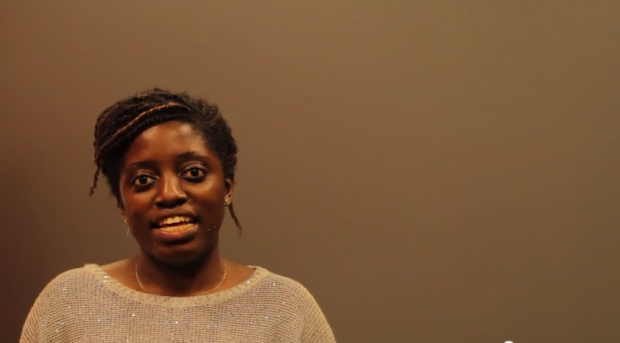
Author: Houghton STAR
The student newspaper of Houghton College for more than 100 years.

The Kerr-Pegula Athletics Complex (KPAC) will be dedicated tomorrow and Admissions anticipates a boost in enrollment to follow the opening in upcoming years.
Ryan Spear, associate director of admissions, said, “We are seeing KPAC as an opportunity to grow enrollment during the coming years by highlighting the facility on tours and working closely with coaches.” In addition, the Admissions office recently hosted a college fair in KPAC, which was represented by 41 local colleges and universities. High schools from Alleghany County and the surrounding areas were invited to attend as well. “We’re seeing KPAC as a chance to hold events like these that will increase awareness of Houghton and what it has to offer,” said Spear. Senior tennis player Jenn Mechler said, “KPAC will be a selling point for Houghton. Having the indoor tennis courts will be beneficial to the team because we won’t need to travel to practice at St. Bonaventure when it rains.”
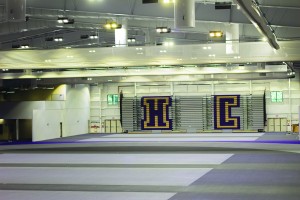 After switching into the NCAA Division III, Spear explained that Houghton wanted to qualify to take part in the Empire 8, an athletics association made up of colleges and universities in Western New York. “We needed better athletic facilities to compete with NCAA Division III schools and to grow the amount of teams we offered,” said Spear. As a result, a $12 million dollar donation was made by Terry Pegula and alumnus Kim Pegula (Kerr) three years ago for the construction of the athletic complex. “KPAC shows competitors that Houghton is serious about athletics and that Alumni are investing money into making it happen,” said Mechler.
After switching into the NCAA Division III, Spear explained that Houghton wanted to qualify to take part in the Empire 8, an athletics association made up of colleges and universities in Western New York. “We needed better athletic facilities to compete with NCAA Division III schools and to grow the amount of teams we offered,” said Spear. As a result, a $12 million dollar donation was made by Terry Pegula and alumnus Kim Pegula (Kerr) three years ago for the construction of the athletic complex. “KPAC shows competitors that Houghton is serious about athletics and that Alumni are investing money into making it happen,” said Mechler.
The donation was not enough to build KPAC entirely. Another $14 million dollars was needed from Houghton in order to complete the facility and has brought some controversy because the college had to go into debt. Mechler said, “It’s a big expense now, but it will be returned when it brings more students to Houghton and when we hold events like the upcoming Tenth Avenue North concert.”
Spear said, “We are tending to the educational, spiritual, and now growing in how Houghton treats the physical health of it’s students, faculty, and staff, which is what a Liberal Arts education is all about.”
Over the last three years, Houghton has added baseball, softball, men’s and women’s tennis, and men’s and women’s lacrosse. Coach Lord, executive director of intercollegiate athletics, said, “When we were a part of the NAIA division, we had about 17 percent of our student body participating in intercollegiate sports. Now we have about 27 percent since switching to NCAA Division III and we hope that number will grow to 33 percent in the coming years.”
While there have been no confirmations on whether or not the Pegula family will be joining the dedication, Coach Lord stated, “We want to show them how blessed we are and how they have contributed so much to the Houghton community.”
“It’s not everyday that you get to dedicate a building, so I hope to see a lot of students at the dedication ceremony” said Coach Lord. During Houghton’s Homecoming and Family weekend, the dedication of KPAC will draw alumni, community members, and students to tour the new building. Spear said, “Most importantly KPAC is for everybody, not just athletes.”
With Addie’s Ice Cream now officially open for business, the limited dining opportunities available around Houghton have increased, but there’s still something missing from the campus. With hungry expectations still to be met and questions that need to be answered, people are wondering, why is the building across from Subway still empty? Where is the anticipated 3 Bums Pizza?
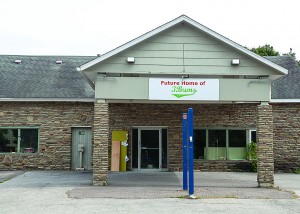 At the end of last semester, students were told that 3 Bums Pizza would be open upon returning this Fall. Currently, 3 Bums is still in the process of transitioning from their previous location in Belfast, to their new building formerly occupied by the Allegany Harvest Cooperative Market. With the original projected opening date of June 1, and mid-September quickly approaching, people are wondering what is accounting for the delay.
At the end of last semester, students were told that 3 Bums Pizza would be open upon returning this Fall. Currently, 3 Bums is still in the process of transitioning from their previous location in Belfast, to their new building formerly occupied by the Allegany Harvest Cooperative Market. With the original projected opening date of June 1, and mid-September quickly approaching, people are wondering what is accounting for the delay.
Owner of 3 Bums Pizza, Jake Hillman, stated, “While we had hoped that 3 Bums Pizza in Houghton would open quite some time ago, several issues have delayed our move. We’ve been working on some pretty extensive renovations the last several weeks, and as the project has progressed, those renovations have become even more extensive. Ever-changing building and fire codes make turning an empty space into a restaurant quite a task.”
Director of Community Relations, Phyllis Gaerte, said, “We are very disappointed at the delay, but in Jake’s defense, they ran into a number of tricky complications with state restaurant codes. Transforming an old convenience store presents unforeseeable challenges that 3 Bums is rising to meet.”
Hillman tells locals, “The good news is that we are in the home stretch of construction and will be open in the coming weeks.”
Soon 3 Bums will open its doors to students and the surrounding area. Business Professor Ken Bates states, “I predict Houghton’s relationship with 3 Bums to be mutually beneficial. It’s hard to imagine a college town without a pizza delivery business. Turning that around, it’s hard to imagine a pizza business in a college town that doesn’t have a big upside in terms of business success.”
3 Bums will also potentially provide opportunities for students, “3 Bums has employed Houghton students part-time in the past and now that they’re in town that will make this even easier.” Bates said. “We in the business department will be delighted to work with Jake in setting up internships with our business students to whatever degree that will work with his business model. Those discussions have yet to happen, but I look forward to welcoming Jake to the Houghton RVER Group meetings and working together to help his business succeed”
In the following weeks, Houghton can expect to see 3 Bums Pizza renovated and open for business. Hillman assures customers that “No one is more disappointed than we are that our new pizza place wasn’t up and running by the time students came back for the fall semester. We are committed to Houghton for the long term and are quite confident that taking the necessary time to make sure everything is done, and done right.”
Ceasefire in Ukraine
A ceasefire was called in Ukraine last Friday, when the Ukrainian government and separatist leaders agreed to stop conflict that has left 2,200 people dead since April. While this is not the first attempt at a ceasefire agreement between the two groups, it is the first time that Russian president Vladimir Putin actively endorsed this action. His endorsement revolved around a 7-part peace plan that he had laid out two days earlier.
 In spite of this, Putin has still been under heavy scrutiny by Western leaders for what they believe to be suspicious political motives in Russian involvement with Ukraine. In spite of this skepticism, Ukrainian president Petro Poroshenko expressed cautious optimism about the cease-fire. In a White House press conference following the recent North Atlantic Treaty Organization (NATO) summit in Wales, President Obama spoke to the Associated Press saying he remained “hopeful but, based on past experience, also skeptical” about the strength of this ceasefire.
In spite of this, Putin has still been under heavy scrutiny by Western leaders for what they believe to be suspicious political motives in Russian involvement with Ukraine. In spite of this skepticism, Ukrainian president Petro Poroshenko expressed cautious optimism about the cease-fire. In a White House press conference following the recent North Atlantic Treaty Organization (NATO) summit in Wales, President Obama spoke to the Associated Press saying he remained “hopeful but, based on past experience, also skeptical” about the strength of this ceasefire.
For now, the focus of the U.S., and other members of NATO have been to support Ukraine in its endeavors, without directly supplying weaponry or allowing the Ukraine to join the treaty organization. In an interview with Time magazine, president of the Atlantic Council of Ukraine, Vadim Grechaninov, stated that he is disappointed, but not surprised. If Ukraine were to be accepted into NATO every member of the organization would be bound to protect Ukraine in this conflict. Many of the allies are hesitant to involve themselves in that type of confrontation with Russia, who is armed with nuclear weapons.
However, NATO has attempted to provide some support for Ukrainian people in a few ways. During the NATO summit in Wales, the five most powerful nations in the organization met with Poroshenko to discuss the conflict with Russia, and collectively pledged $16 million dollars in trust funds to help modernize the Ukrainian military. The most influential tactic used by NATO members, however, are the sanctions against trade with Russia. A CNN article wrote that the European Union, in addition to their current sanctions against any arms or dual-purpose items, is looking to restrict capital investments with Russia within their union, as well as sensitive technologies and certain energy-related equipment.
In his interview, Grechaninov recognizes the actions taken by members of NATO to help restore peace to the region, but doesn’t believe they are sufficient. “Putin can only be stopped by a force greater than his,” he said. “We waited for this force from NATO, and they have it. They can stop Putin. But right now they don’t consider it. “President Obama has a different opinion on the impact that NATO has had in the Ukrainian conflict. During his White House press conference, he stated that the only reason that Russia was agreeing to a ceasefire is because of the impact that current sanctions, as well as threat of future sanctions will have on the Russian economy.
The future remains unclear in Ukraine as current world leaders are still cautious about the stability and strength of the current ceasefire between the two groups. A diplomatic solution cannot currently be reached, as many separatists are divided on their goals for the conflict. In response to the future, Ukrainian Prime Minister Arseniy P. Yatsenyuk told the New York Times that lasting peace would only come about in response to three things: a long term cease fire, a withdrawal of the Russian army, and a wall along the border. According to CNN, the last unilateral ceasefire declared by the Ukrainian government in June broke down after ten days.
Living Within Our Means
Every day there are many of us that inflict damage upon this world with our highly consumerist lifestyles.

My parents blew their money and their credit scores before I was even born. When they began to think about the consequences of their financial decisions, it was too late. As a result, they resolved to raise frugal, financially responsible children. “Live within your means,” was one of their top five phrases of parental advice, along with “Marry rich the first time around” and “Always check your receipt before you leave the parking lot.” (See a pattern?) “Live below your means” was employed when times were tougher or when my siblings and I perched hopefully on a stationary 25-cent ride outside of K-Mart. Living below their means was their way of remedying the damage that had already been done. However, what if we instead understand “means” as all resources available to us?
By “means,” my parents are talking about income, monetary resources. I’ve got that down (except maybe for the money going to my private, liberal arts education). I want to know what it would look like if we lived within all of our means. The earth, the waters, air. Electricity, fossil fuels. Paper, plastic, metals. Textiles, animals, food plants. These resources are not unlimited, and when we use more than the earth can provide and more than we need, we exploit the creation within which we live and further marginalize the people who manipulate and produce the resources to cater to our indulgent lives.
So, how does one practice life within the means of the world? Perhaps, considering our current state of environmental, fiscal, and social crises, we should be living below our means for a while. Sometimes I think that the only way to do this is get rid of all I have and run away into the woods like a wild animal. As tempting as that can be, I only know one or two people who might be ready and determined enough to make such a drastic change in their lifestyles. I do not happen to be one of them.
I agree with the wise Disney character, who once sang, “We are all connected to each other in a circle that never ends.” As long as you live, you cannot escape other life. Our actions, my actions, your actions, have an impact. Our choices make this world what it is. My parents’ decisions not only affected who I turned out to be, but also the economies, communities, and ecosystems of which they were a part. So do yours. Most often, our decisions will affect those who are poor and marginalized around the globe.
Except for the few who will leave civilization completely behind in pursuit of communion with the earth, every person will always be able to do something more to live sustainably. In a way, this idea beautifully clarifies the connectedness of all things by defining the role that humans must play at this point in our history. Our role is to act on our awareness of the state of the world’s resources. Our role is to attempt positive change, taking one step at a time toward harmony. The beauty of this lies in our human capacity to persist in the convictions that proceed from genuine reflection.
In The Long-Legged House, Wendell Berry writes, “We have lived our lives by the assumption that what was good for us would be good for the world. We have been wrong. We must change our lives so that it will be possible to live by the contrary assumption, that what is good for the world will be good for us.” That is a call for radical change. Radical change exists on a continuum that ranges from extreme to reasonable. Change like this can happen one step at a time. Richard Meyer said, “We’ve got to be willing to put in sustained time and energy to create change, and we’ve got to remember that things move at a pace that may feel too slow. If we do nothing, the pace will be nonexistent.” Although he was talking about the educational system, I think this philosophy can be applied to all areas that warrant change. To begin acting on this, the question we must every day be asking ourselves is: How can I live in deeper peace with the world to which I am so closely connected, the world that supports me?
I wish my parents had considered their financial future (me) before it was too late. When I consider the way I live and consume, I will remember those who come after me. But more than that, I want to live in this moment peacefully and in harmony with the world, including the people and resources in it.
Artist of the Week: Aaron Fitzgerald
[slideshow_deploy id=’872′]
 Aaron Fitzgerald
Aaron Fitzgerald
Stories are the gateway into new worlds, experiences, and ideas. Not only can they expand our view and understanding of the world, but they can also impact and inform them. I have always been fascinated with the power of narrative. As a storyteller, I dream of changing and informing the world, while being changed and informed by it.
Artist of the Week: Tricia Powles
[slideshow_deploy id=’755′]
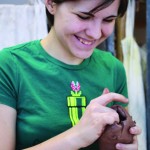 Tricia Powles
Tricia Powles
I love sculpture, primarily sculpture done in clay. There is something about the relationship with the material, the hands-on-ness of it, that other media lack for me. I am inspired by trees, Surrealist landscapes, organic form and line, the way that muscles bunch up and skin stretches across bone. I love creating something precious and releasing it to the fire, to thrive or fail.
“The creative habit is like a drug. The particular obsession changes, but the excitement, the thrill of your creation lasts.” –Henry Moore
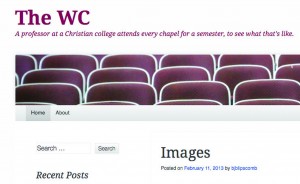
thedoubleusee.wordpress.com
At the start of the spring semester, Professor Benjamin Lipscomb, philosophy, began a ritual of not only attempting to attend every chapel from now until the end of the school year, but also of documenting each experience via online blogging.
When asked what he hopes to achieve from undertaking such an intentional challenge, Lipscomb said, “It’s several things; it’s wanting to be more gratefully receptive to the work of my colleagues who put the chapels on, the students, the chapel deacons… it’s partly just seeing what it’s like or what it might do for me; partly to get a better sense of the value or lack of value of it.”
Though the blog’s origin and ultimate subject is Houghton College, Lipscomb aims towards a broader audience by minimizing the use of names and allowing chapel lectures to lead him to more broadly relatable topics.
He said, “I try to keep it anonymous in some small ways. I don’t use the name ‘Houghton’; I edit comments if they use the name ‘Houghton.’ I never use the name of anyone on campus.”
Lipscomb establishes his goal for such anonymity by saying, “It’s something that also maybe makes [the blog] more widely accessible, as something that someone might be interested in who’s not a Houghton person. I try to make it about a certain kind of experience that’s recognizable in a number of evangelical communities or evangelical colleges.”
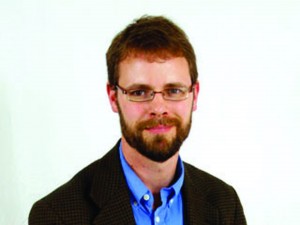
Professor David Huth, visual communication and media arts, and friend of Lipscomb, said, “The blog certainly isn’t ‘about’ the chapel events, or the chapel program, or even Houghton College. If you read his posts, you can see that all of these things are simply jumping-off places for reflections and questions in his mind. The structure and schedule of Houghton’s chapel programming (and general subject matter of religion and community) are providing prompts for Professor Lipscomb’s thinking.”
Lipscomb’s interest also resides in the exploration of the idea that a mandated chapel schedule serves as a shared, communal experience.
In the first entry of his blog, he wrote concerning this aspect of chapel, saying, “I think it’s supposed to contribute to the formation, both of the spirituality of individual community members and of a communal ethos. And I’m not being formed in whatever way that is, or not much. I wonder too what difference it might make in my interactions with students if we had this experience in common. Would it become a topic with us, a point of connection?”
As the college requires regular chapel attendance of students, and faculty are encouraged to do the same, chapel acts as a point of intersection, which tends to elicit interaction or common conversation amongst chapel attendees.
When asked more about this idea of exploring the effects of such a shared experience, Lipscomb said, “What do I hope might come of it? I hope more conversation about chapel – not only critical; not even principally critical… We’re a college; we’re a community of intellectual conversation. The more I can cultivate or provoke people to talk about what they’re experiencing, what they’re listening to… the happier I’ll be.”
Thus, Lipscomb views his goal of faithful chapel attendance as not exclusively an act of self-discipline, but rather an act of community.
While discussing such an idea, Lipscomb went on to say, “I’m joining in the community in a way that I haven’t been required to… It seems to me it heightens the sense of community, it makes some more community than there would be otherwise, between the students and myself. It gives me a chance to see how chapel functions, or whether it functions in that way.”
Since Houghton College refrains from requiring faculty members to attend chapel lectures like it requires of its students, Lipscomb’s new habit also functions as a deliberate act of self-discipline.
Lipscomb plans to explore the students’ chapel requirement in light of the faculty’s lack of requirement.
He said, concerning Houghton’s current chapel practice, “It’s coerced. Sometimes coercion ends up working for our own good; sometimes it’s just coercion… there are times when we are coerced to do things that are for our good and we’re glad in the end that we have been. I almost wonder whether the choice should be, ‘We will coerce this of our students and of ourselves as the rest of the community, or we won’t do either.’”
By willingly placing himself in the position of Houghton students, who are required to attend two-thirds of all regular chapels offered, Lipscomb hopes to relate to such an experience while simultaneously analyzing its purpose.
As Lipscomb muses in his blog, “The students living under the requirement–they’re busy. They make the time; they have to. What would it be like for me, I wondered, if I did too?”
To read Lipscomb’s blog go to http://thedoubleusee.wordpress.com/
